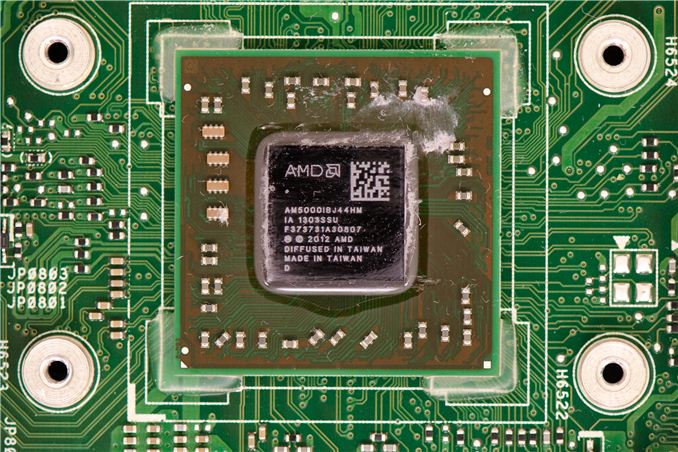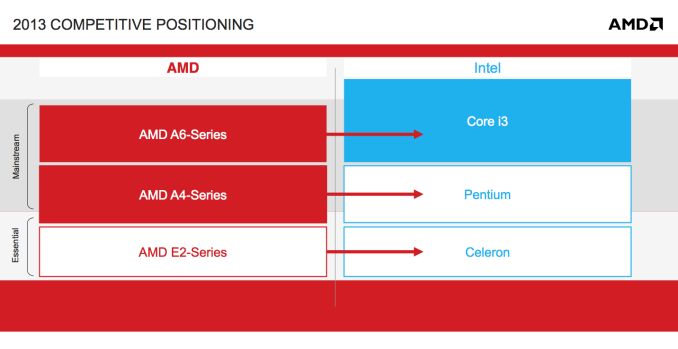The Kabini Deal: Can AMD Improve the Quality of Mainstream PCs with Its Latest APU?
by Anand Lal Shimpi on May 24, 2013 1:45 PM EST
There are two non-negotiables in building a PC these days: the cost of Intel silicon and the cost of the Windows license. You can play with everything else but Intel and Microsoft are going to get their share. Those two relatively fixed costs in the PC bill of materials can do one of two things: encourage OEMs to skimp on component cost elsewhere, or drive the entire ecosystem to supply higher quality components at lower prices. If you’ve been following the PC industry for the past decade, I think we’ve seen more of the former and less of the latter.
Apple occupying the high-end of the notebook PC space has forced many OEMs to reconsider their approach, but that’s a more recent change. What AMD seems to offer is an easier path. AMD will take less of the BoM, allowing OEMs to invest those savings elsewhere - a move Intel will never make. Given how much pressure the PC OEMs have been under for the past few years, AMD’s bargain is more appealing now than it has ever been.
With Llano and Trinity, AMD’s story was about giving up CPU performance for GPU performance. With Kabini, the deal is more palatable. You only give up CPU performance compared to higher priced parts (you gain performance compared to Atom), and you get much lower power silicon that can run in thinner/lighter notebooks. Typically at the price points Kabini is targeting (sub-$400 notebooks), you don’t get pretty form factors with amazing battery life. AMD hopes to change that.
While AMD hasn’t disclosed OEM pricing on Kabini (similarly, Intel doesn’t list OEM pricing on its mobile Pentium SKUs), it’s safe to assume that AMD will sell Kabini for less than Intel will sell its competing SKUs. If Kabini’s die size is indeed around 107mm^2, that puts it in the same range as a dual-core Ivy Bridge. AMD can likely undercut Intel a bit and live off of lower margins, but there’s one more component to think about: Ivy Bridge needs its PCH (Platform Controller Hub), Kabini does not. As a more fully integrated SoC, Kabini’s IO duties are handled by an on-die Fusion Controller Hub. Intel typically charges low double digits for its entry level chipsets, which is money AMD either rolls into the cost of Kabini or uses as a way of delivering a lower total cost to OEMs.
Traditionally, OEMs would take these cost savings and pass them along to the end user. I get the impression that AMD’s hope with Kabini is for OEMs to instead take the cost savings and redeploy them elsewhere in the system. Perhaps putting it towards a small amount of NAND on-board for a better user experience, or maybe towards a better LCD.
As we found in yesterday’s article, Kabini does a great job against Atom and Brazos. However, even with double digit increases in performance, Kabini is still a little core and no match for the bigger Ivy Bridge parts. Much to our disappointment, we pretty much never get sent low end hardware for review - so to make yesterday’s NDA we had to stick with 17W Ivy Bridge and extrapolate performance from there. In the past day I grabbed an ASUS X501A system, a 15-inch entry-level machine priced in the low $300s. More importantly, it features a 35W Ivy Bridge based Pentium CPU: the dual-core 2020M.
The Pentium 2020M’s base clock speed is still relatively high at 2.4GHz, but there’s no turbo. In the low level CPU performance analysis yesterday I used a Surface Pro with a 17W 1.7GHz Core i5, but max turbo on that part can hit 2.6GHz. I actually don’t expect there to be huge CPU performance differences between the results from yesterday and what I have here but I wanted to be sure.
The bigger difference is actually on the GPU side. While a mobile Core i5 comes with Intel’s HD 4000 graphics, the Pentium 2020M gets a vanilla Intel HD GPU. At 22nm, Intel’s HD graphics is a 6 EU part with lower performance than the previous generation Intel HD 3000.
With that said, let’s see how Kabini (AMD’s A4-5000 in particular) compares to an Ivy Bridge based Pentium 2020M in CPU performance, GPU performance and finally in power.











108 Comments
View All Comments
kyuu - Saturday, May 25, 2013 - link
A Surface tablet running off Kabini -- with the consequence of much better battery life and a lower price -- would be great. I hope Microsoft is looking at Kabini/Temash for the v2 Surfaces.FwFred - Sunday, May 26, 2013 - link
I hope they are, though I expect Bay Trail to have better performance, thermals, and battery life in a fanless tablet form factor. May the best SoC win!vision33r - Friday, May 24, 2013 - link
Since when do we need high performance CPUs for Facebook, Reddit, and Porn.nunomoreira10 - Saturday, May 25, 2013 - link
since flash :pJarredWalton - Monday, May 27, 2013 - link
Just as a related comment: I tried several FB Flash games on Kabini and Core i7 ULV. (I know: i7 ULV is a bit much, but it's all I have right now in the ULV segment.) Bejeweled Blitz averages around 24FPS on Kabini, with dips into the low teens at times; on i7 ULV it's pretty much locked in at 30FPS. Zuma Blitz ups the maximum frame rate to 60, and i7 once again hits that pretty much constantly; on Kabini, it's usually above 30 but not always at 60, but at least it's playable. The last game I tried is Solitaire Blitz, and it also tops out at 60FPS; i7 comes close (usually in the 50s), Kabini is lower, like in the 30s. I didn't really have a good way to do apples-to-apples frame rate comparisons, so take these initial numbers with a margin of error. Kabini is definitely better than Brazos and Atom here, but it's not going to handle all the "light" Flash games. And for that matter, ULV Celeron and Pentium are likely in the same boat, but I can't say for certain as I lack the hardware to verify this.kyuu - Saturday, May 25, 2013 - link
If you look at the Tom's Hardware review, it's pretty apparent that the 15W TDP is *very* conservative. Compared to a 17W ULV Ivy Bridge, the 15W Kabini uses significantly less power.100% agree with your conclusion though -- we need an enlightened OEM to use this silicon to build a low cost but good quality ultraportable/thin+light/whatever design. That's the sort of thing I've been waiting to jump on but the OEMs just haven't delivered anything.
mayankleoboy1 - Saturday, May 25, 2013 - link
Enlightened and OEM do not mix together. (Apart from apple, maybe).I am very sure that cheaper silicon=cheaper notebook. OEM's arent going to improve the quality of the chassis and display.
kyuu - Saturday, May 25, 2013 - link
I agree that "enlightened OEM" is, unfortunately, something of an oxymoron. There's always the hope that we'll get surprised, though. Hopefully the downturn in PC sales will make OEMs consider different designs, as it becomes plain that their previous ethos are not going to work anymore.Bobs_Your_Uncle - Saturday, May 25, 2013 - link
I'm very interested to see what would (will?) be done with these AMD APU series in the hands of Vizio, as I very much like the stylistic directions they have taken. By most accounts I believe their initial product launch, (while not exactly awe inspiring), was generally considered to be a reasonably sound first effort, and a well executed one. Reviews I've read suggest that Vizio is indeed serious and directed in their approach toward product improvement in successive iterations.Operating at a much smaller scale than the Big Boys and Girls in the consumer space, in theory Vizio should be more nimble and capable of quicker product deployment to market. This assumes of course, that they have the necessary technical personnel and funding available, and that both their supply and manufacturing resource chains are solid. In light of resource requirements and flagging PC sales, I have to wonder if the favor they've generated with MicroSoft (eg. products sans bloatware, etc.) might pay some dividends.
Given their strengths in design, displays, and the degree to which Vizio employs word of mouth to generate buzz, one or two very solid thin & light notebooks built on an AMD platform (to say nothing of a tablet or two) might provide significant product and brand differentiation, and could really help to build upon a reputation for quality and for responsiveness to market inputs.
With any luck, before too long we'll be reading in AT of something(s) Vizio that is(are) the absolute Bees Knees!
Gaugamela - Saturday, May 25, 2013 - link
Asus already has a great chassis for these APUs. The Asus x202e. If they used a Kabini APU in this chassis they could offer it at an even lower price point.